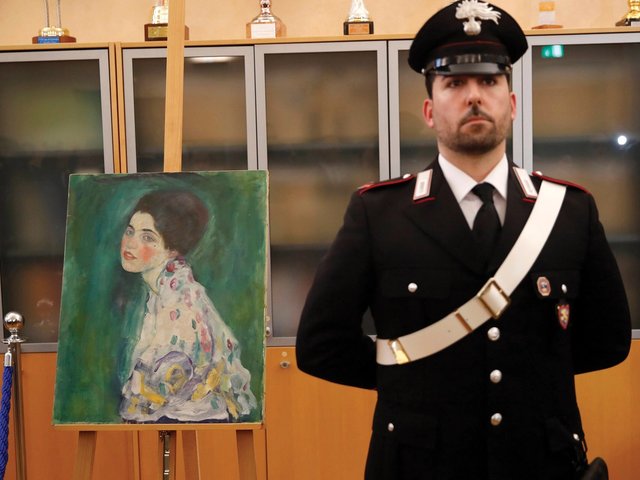Kingston
After four years of “tropical vacation”, twenty-eight stolen paintings are finally to return home to Bettona Museum, near Perugia, Italy, from where they were stolen on 27 October l987. The works, which include two Peruginos, have been valued at around US$8.2 million (£4.9 million) by Guglielmo Malchiodo, the curator of Bettona Museum. They were found on 26 April l990, in a raid on a villa in St Catherine, decorated with portraits of Bob Marley and Nelson Mandela. The villa belonged a forty-eight year old meat-trader and former JLP caretaker for North West St Catherine (JLP, the Jamaica Labour Party, is in fact a right-wing organisation), called John Franklyn.
Franklyn was arrested, accused of “receiving stolen property”, and after the Mayor of Bettona and the curator of the museum arrived in Jamaica and identified the paintings, he was convicted, on 4 January l99l, as having known the paintings were stolen, and he was sentenced to two years prison with hard labour. He then applied for bail, but the claim was rejected and it was ordered that the paintings be returned to Bettona museum. Under oath during the first trial, Franklyn denied that he knew the paintings were stolen and appealed against the verdict, but after hearings on 4 and 5 March l99l at the Jamaica Court of Appeal, this appeal was rejected on 22 March l99l. The following Monday, Ambassador Provenzano, the Italian ambassador to Jamaica, took the paintings to his residence, from which they were to be immediately returned to Italy. At the time of writing, they had not yet left the Island.
During his trial, all that Franklyn had to say about the paintings was that he could not bear to bring them into his house because they were “the ugliest things I ever did see” and “only good for chasing away ghosts”. So ugly were Perugino’s masterpieces, “The Madonna of the Misericordia with SS. Manno and Girolamo” (said by Malchiodo to be the most valuable at US$3.5, £2.l million) and “Saint Antony of Padua and devotee” that he had left them upside down outside in his yard in the bright Jamaica sunshine. Numerous moves in and out of crates had also left the pictures badly scratched. Before their return home, the pictures will be restored in Rome.
So how did a Jamaican meat-trader come to be in possession of a group of stolen Italian paintings, of whose value he seemed to be completely unaware? The paintings were sent to him in two crates from London, arriving in Jamaica on l9 June l988. This is known from the Bill of Lading, a document which entitled Franklyn to clear the goods from the wharf. Franklyn did not declare their value and the crates were cleared by his customs brokers without an invoice. The valuation of the contents of the crates was a mere J$3,000 (US$376, £200) and the total duty J$2,990 (US$374, £l99). The matter slipped through the Jamaican customs without any expert valuation. The paintings had also eluded customs in London because of deliberate concealment of their value. From the wharf they were taken to a house owned by Franklyn and rented by one Marcia Lee Betty, where they remained undetected for some time.
Franklyn originally told the court that the paintings were a gift sent to him by someone called Gordon Fernhead (in the notation Fernhead declared himself to be a British subject, resident at “Warwick”, Catell Road, England). He said Fernhead was the co-ordinator for a group of Europeans who were spearheading a project to build a Spanish village in Mammee Bay, Ochos Rios, St Ann, to celebrate the 500th anniversary of Christopher Columbus’s entrance into the New World. The paintings were going to be put in the houses there. The project, said Franklin, had been abandoned and Fernhead had said he could keep the paintings. Not surprisingly, the Magistrate dismissed this story as “at best a concoction”.
However, Franklyn tried to save his bacon by changing his testimony, showing an invoice for £l5,000 (US$26,000) from Fernhead, who he then said had told him that the paintings were bought in Japan and that “the plan for all the things was to sell them, including the paintings”. The invoice came from Gordon’s Antiques, Catell Road, Warwick. Throughout the trial, John Franklyn showed no remorse, according to Giuliano Lemme, the Italian lawyer, who was present. “He was fat and smiled stupidly; he must have been a puppet”. It certainly looks as though the mysterious Fernhead could not get rid of the pictures quickly enough.
The Italian police claim to know who carried out the theft from Bettona Museum, but cannot convict the suspects because they have fled the country and are believed to be in South America.
Originally appeared in The Art Newspaper as "‘The reluctant collector: “The ugliest things I ever did see....only good for chasing away ghosts”


